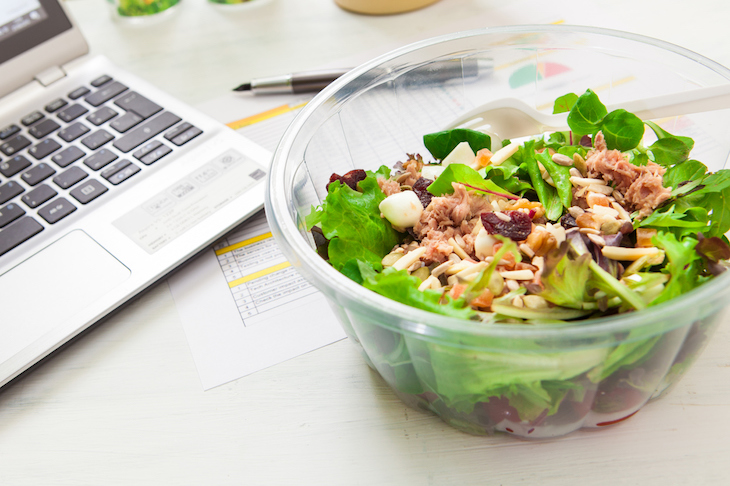As a young sub-editor on the Times in 1926, Graham Greene, future author of The Quiet American and Brighton Rock, had his meals in the office canteen. Elevenpence bought two kippers, a pot of tea and a slice of syrup roll. Plenty to keep a man going through a long subbing shift.
Is that ‘pot’ of tea not civilised, with its suggestion of several cups, of the ceremony of brewing and pouring? With a hot main and a hot pudding eaten away from one’s typewriter?
Today’s office worker eats al desko. Quick dash to Pret, Eat, Itsu, Leon — it’s as if we haven’t time for more than four letters — for the same sandwich, sushi box or wrap as yesterday. Back to wolf down bacon, lettuce and tomato before a one o’clock meeting. What should be a pleasant pause in the working day is a bad-tempered, hiccupy bolting of just enough calories to get you through to the afternoon tea-run.
It’s a depressing way to eat at any time of year, but particularly in September, after two weeks away in la France profonde, Porto or Tuscany. Long lunches under the arbour. New bread, ripe tomatoes, spiced saucisson, juicy peaches. A siesta in the heat of the day. Then, back to lacklustre lunches and crumbs on the keyboard.
Visiting Paris in July, the lunchtime cafés were full of office staff ordering the prix fixe menu over their newspapers (‘La chanteuse Rihanna “inspirée et impressionnée” par Emmanuel Macron’). Carottes rapées to start, then roast chicken, buttered potatoes, endive salad, coffee of your choice — all for ten euros. The Parisienne does not ask her neighbour at midday: ‘Shall we do M&S now before the rush?’ She does not go in pairs, or threes, or fours with the girls from accounts to buy a meal deal from Boots. She sits at her table toute seule, in splendid Gitane-smoking isolation.
Since we are not rich in sumptuous little bistros serving steak-frites for a sou, we must make the best of our desk lunches. The most popular office lunch in this country, according to a 2015 survey, is the cheese sandwich, followed by the ham sandwich, followed by the chicken sandwich, then some sort of salad, and in fifth place, ‘other sandwich’. Must try harder.
Swap a sandwich for slices of quiche Lorraine; pork pies with red-onion chutney and cherry tomatoes; cold roast chicken with piccalilli and new potatoes saved from Sunday’s lunch; Scotch eggs and pink radishes; quarters of egg frittata with feta, courgettes, peas, spring onions. Love Your Lunches by Rebecca Dickinson (Hardie Grant, £12.99) has an autumn recipe for a caramelised onion, mushroom and goats cheese frittata. I’ve tried it: it’s delicious.
Don’t eat quinoa at your desk. Once it gets in the keyboard grooves, you’ll never get it out.
In The Home Cookbook, gardener Monty Don confesses his modest lunches: ‘I have been known to lunch perfectly happily on half a cold baked potato spread with homemade chutney for first course, and the other half spread with jam for pudding.’ Frugal, filling, and very British.
There was a heated debate in the Telegraph letters pages this summer about Cornish pasties and whether they were taken into the fields for lunch by farm workers, filled at one end with meat and veg and at the other — on the Monty principle — with apple and dried fruits. But how, asked the letter writers, would one know which was the savoury end and which the pudding end and where to start?
Cooked fish in the office is tricky. Did the smell of Graham Greene’s kippers ever leave the Times corridors? Your colleagues won’t thank you for eating mackerel, herring or microwaved kedgeree. But you can just about get away with potted shrimp or Gentleman’s Relish on good oatcakes: Stockan’s Orkney or Duchy Originals.
There was a mutiny at one office I worked in when an editor put herself on a six-eggs-a-day diet. Those sitting nearby learned to dread the click-clack of the Tupperware and another hard-boiler sulphurously extracted.
The most wilfully extravagant and eccentric lunch I’ve come across belongs to a friend who works in the City. He takes in a tin of Clement Faugier cooked chestnuts and eats them whole with a fork.
Susannah Otter, a books editor with a passion for proper lunches, says: ‘My best lunch tip is to create a condiment drawer. Seems pretentious, makes everything better. Mine has celery salt, chilli flakes, a small bottle of Tabasco, Dijon and English mustard, olive oil, a pepper mill and sumac (brilliant on pretty much everything). Then, even if you do get stuff from M&S, you can assemble bits and bobs and season them as you wish. I went through a very enterprising stage of making my own dukkah.’
She recommends Georgina Hayden’s recipe in Stirring Slowly: Recipes to Restore and Revive (Square Peg, £20) for this Egyptian spice mix of sesame, coriander, cumin and fennel seeds, blanched almonds, sea salt and black pepper.
If you are stuck in a cheese toastie rut, The Little Book of Lunch by Caroline Craig and Sophie Missing (£16.99, Square Peg) is full of inspiration under sensible chapter headings, such as: ‘When you are chained to your desk’ and ‘Bribing colleagues with sweet treats’. Posh Toast by Emily Kydd (Quadrille, £12.99) is a book to raid when you can’t think of anything more exciting than a ploughman’s sarnie. Crushed cannellini beans with sage and lemon on sourdough toast is a winner.
Tiffin tins, bento boxes and Thermos flasks for soup make even the dreariest bloomer-loaf sandwich more sybaritic. Keep a stash of sugar in your drawer, hidden from colleagues behind the hole-punch: Mint Imperials, Medjool dates, Percy Pigs, dark chocolate coffee beans. This is the place for the treats
you bought on holiday and have no idea what to do with: sugared almonds, crystallised violets, amaretti biscuits and quince membrillo. Pop a marron glacé and plan your next holiday.
Laura Freeman and Thomas Marks revamp lunch on The Spectator Podcast.
Got something to add? Join the discussion and comment below.
Get 10 issues for just $10
Subscribe to The Spectator Australia today for the next 10 magazine issues, plus full online access, for just $10.
You might disagree with half of it, but you’ll enjoy reading all of it. Try your first month for free, then just $2 a week for the remainder of your first year.















Comments
Don't miss out
Join the conversation with other Spectator Australia readers. Subscribe to leave a comment.
SUBSCRIBEAlready a subscriber? Log in